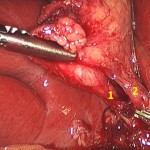Cholecystectomy is the removal of the gall bladder. Cholecystectomy is a common treatment of gallstones that are causing symptoms and certain other gallbladder problems. Surgical options include the procedure, called laparoscopic cholecystectomy which is done through the use of a camera, and the more invasive procedure is called open cholecystectomy where the abdomen is opened. There are many possible surgical errors that commonly result from this procedure. The most common surgical error is penetrating or dividing a bile duct. The most common injury is to the common bile duct. See: http://www.ncbi.nlm.nih.gov/pubmed/10436513 and http://www.ncbi.nlm.nih.gov/pubmed/9108760. Injuries to arteries (commonly the right hepatic artery) can also result in increased morbidity and mortality. Malpractice most commonly occurs as a result of the surgeon dividing a structure that was misidentified. The two structures that connect the gall bladder to the body are the cystic artery and the cystic duct.
The wrong structures are commonly divided due to the failure of the surgeon to obtain the “critical view” (http://www.cirignani.com/Articles/Hidden-Cystic-Duct-Syndrome-and-Infundibular-Technique.pdf) of the structures by proper and adequate dissection and therefore the surgeon misinterprets the anatomy. Aberrant anatomy is very common in this area of the body, especially involving the bile ducts and the hepatic arteries. Sometimes there are extra or accessory arteries and/or ducts and sometime the arteries and ducts may arise from aberrant locations.
The best practice to obtain the critical view involves the use of a cholangiogram. This test involves the use of radiopaque dye and imaging to provide further assurances that the surgeon has properly identified the proper structures. Dye is injected into the structure that is identified as the cystic duct and allowed to flow. Then a fluoroscopic image is obtained and viewed during the surgery which should establish that the flow is into the common bile duct and then into the small bowel, with up flow in the common bile duct towards the liver as well. If properly interpreted this should obviate any misidentification.


The top above image demonstrates the obtaining of the critical view of safety prior to division or cutting of the structures. The structure on the left is the cystic duct which connects the gall bladder to the common bile duct. The key is obtaining a clear view that the structure enters the base or infundibular of the gall bladder and that it isn’t another structure coursing above or below the infundibulum of the gall bladder.

The critical view must be obtained before transection of any structures. The critical view is achieved when only 2 structures can be seen entering directly into the gallbladder.
The lower above image demonstrates the multiple possible aberrant arterial presentations. There are also aberrant ductal presentations as well.
If there is a surgical error, a good attorney should be able to develop evidence through the medical records, deposition testimony and imaging studies to establish malpractice on the part of the surgeon. If there are any questions about the identity of the anatomy the laparoscopic procedure must be immediately converted to an open procedure so a clear view of the anatomy and any aberrant structures can be identified. Any mistaken divisions must be corrected immediately or very shortly after the original surgery and perhaps with a specialist at a different facility. Even if errors are corrected there may be long term problems. Each case is different and it is critical to have an attorney that understands the entire picture. That means that a good attorney who is able to be a strong advocate must understand the procedure, the anatomy, the medical literature and the imaging studies. A good attorney takes on the surgeon in their own backyard and can get down in the dirt and win on the surgeon’s terms.

Leave a Reply